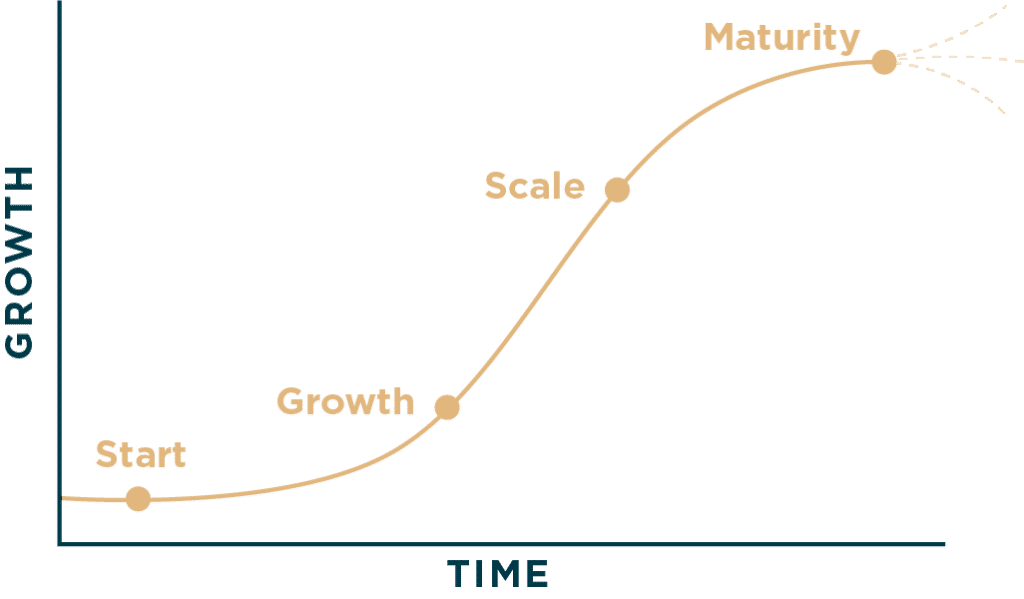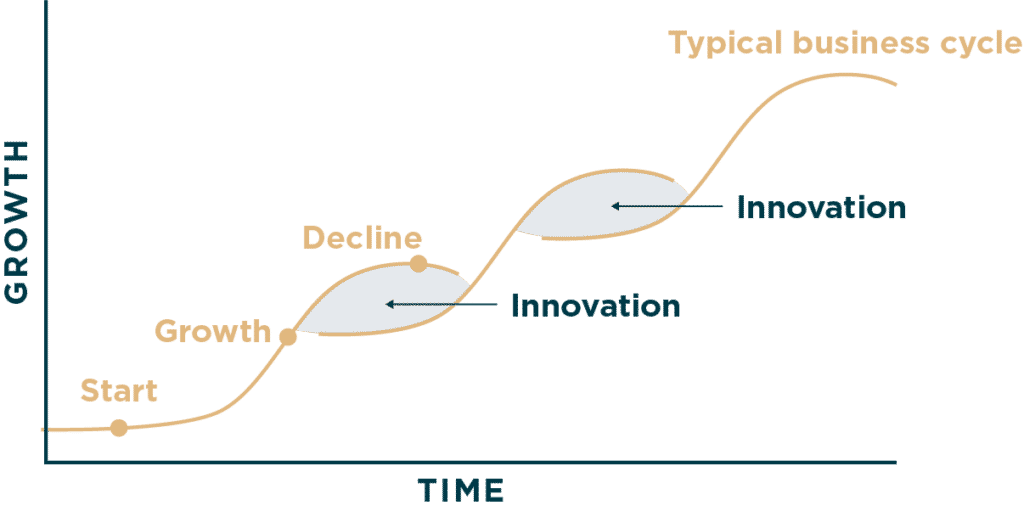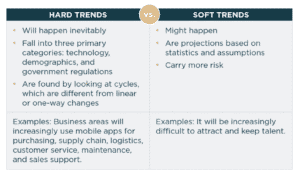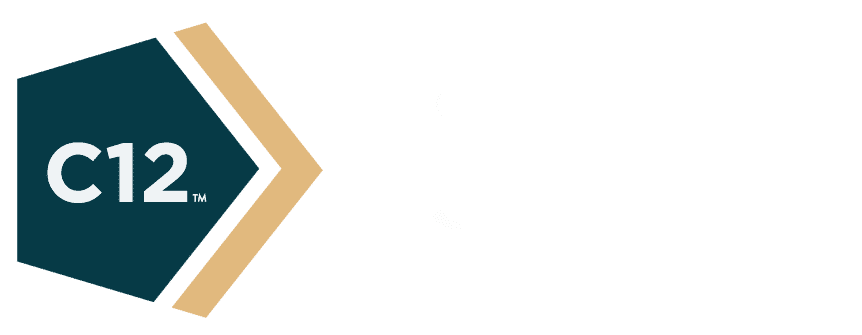Navigating the S-Curve in Your Business
How to Recognize and Prepare for Strategic Inflection Points
Strategic inflection points. They come to every business.
Our business is doing well. Our products are valuable. Our customer base is growing. Our business has reached a season of maturity, at the apex of what management thinkers call the “business s-curve.”
But then something happens. The market fluctuates. Technologies evolve. Competitors make adjustments and target our customers. A previously groundbreaking product isn’t as impressive or unique. An acquisition strategy fails. A new innovation changes the industry.
The changes often catch leaders by surprise. And if we have been complacent, we may not be prepared.
Strategic inflection points require leaders to be humble, agile, and willing to innovate. They require a shift. And shifts in business are serious.
Ignoring the Business S-Curve: A Cautionary Tale
In the early 2000s, Blockbuster Video was the #1 brand in the video rental space. During this season, Blockbuster was courted by Netflix CEO Reed Hastings with the opportunity to purchase the DVD-by-mail rental company for $50 million. Blockbuster turned down the offer. At the time, CEO Jim Keyes famously said, “Neither RedBox nor Netflix are even on the radar screen in terms of competition.”
Blockbuster was riding high at the top of the business s-curve. And this moment was its strategic inflection point. In the face of this opportunity, they lacked the vision to anticipate where the home video industry was going and that their business was about to experience a major disruption.
By 2010, Blockbuster had filed for bankruptcy. As of March 2022, Netflix reported a market cap of $165.97 billion.
The Business S-Curve Explained
Observations about the seasonality of life and work have been described in wisdom literature for centuries. In the Bible, King Solomon put it this way.
“For everything there is a season, and a time for every matter under heaven.”
This timeless truth also applies to the life cycles of our businesses.
The business s-curve is based on decades of business research. Also known as life cycle thinking or the “sigmoid curve,” management thinker Charles Handy first applied it to organizational and individual development in the mid-1990s.
Stepping back and taking a long-view of business growth trends, Handy uncovered an interesting insight. Following the growth trajectory in multiple businesses, one can discern similar patterns mapped over time.
According to Buckley Barlow, a founding partner at RocketSource and author of “The S-Curve of Business,” the S-shape represents growth over time—starting out slowly, picking up speed during rapid growth, then tapering off as growth slows.
Business growth can thus be plotted into a set of predictable stages. These stages are:
- Start
- Growth
- Scale
- Maturity

The Four Stages of the Business S-Curve
Each stage along the business s-curve has a specific set of characteristics. Each stage also brings a unique set of challenges.
Stage 1: Start
Growth is slow as we test the market, develop our products, and begin to gain customers. At the same time, we’re building company operations, procedures, and values.
Questions to ask in the start stage
- Who are the customers we should serve?
- What are their current needs?
- How can we viably meet those needs with innovative solutions?
Stage 2: Growth
Growth and cash flow is increasing. We need to maintain profits while reinvesting in personnel and systems.
Questions to ask in the growth stage
- How can we best meet the increased customer demand?
- Where can we find the right people to join our team?
- What should we delegate and outsource?
Stage 3: Scale
We have a high-performing team, streamlined systems and processes, a valuable product or service, and an established brand.
Questions to ask in the scale stage
- Should we expand the business in other markets?
- How should we adjust our operations, marketing, and sales?
- Can we support this financially?
Stage 4: Maturity
Our focus is on maintenance and consistency of our products and services, while allowing innovation to move us forward.
Questions to ask in the maturity stage
- How do we maintain customer loyalty amidst increased competition?
- How do we handle increased price pressures and reduced margins?
- How do we become more efficient and keep employees motivated?
The first half of the curve, from “start” to “scale,” is the stage with the greatest profit and growth potential. The second half of the curve, starting at “maturity,” typically brings increased competition, flattening demand, price pressure, and reduced margins.
The Business S-Curve: Dangers in the Maturity Stage
In natural terms, life beyond maturity leads to decline and death. In business terms, life beyond maturity can lead to growth stalling, stagnating, and then declining.
It takes a brave and humble leader to recognize a business has reached a stage of stagnation and decline. These moments of realization are difficult indeed.
In the normal course of business, our teams may be too close to recognize the first stages of stagnation or decline. They may not, like Blockbuster, realize a new competitor or societal trends (or both) could negatively impact the business. Even worse, even if our teams do notice the trends, they may have concerns about mentioning these challenges to a boss.
Instead, these critical moments of realization often come, not when “working in the business” but when “working on the business” in a Christian business forum, a peer advisory group, or with an executive coach.
Growth Beyond the Business S-Curve
So what should a business leader do when they start to see signs of stalling, stagnation, and decline?
If we’re unprepared for this question, we can panic and make poor decisions. But if we’re prepared to innovate, we can sustain momentum and lead our companies towards renewed growth.
Leaders who survive and thrive past the maturity stage of their business learn to recognize the signs of stalling, stagnation, and decline—not as reasons to panic—but rather as a strategic inflection point. The maturity stage of a business becomes, not a sign that the business has “made it” but instead a sign that it’s time for innovation.
As we can see on the graph below, in a healthy business that embraces change during a strategic inflection point, one business s-curve leads to another business s-curve and so on.

Each strategic inflection point becomes an opportunity for innovation. Wise leaders will prepare for their next strategic inflection point well before their companies reach the maturity phase on the s-curve.
Navigating Your Strategic Inflection Point
“The difference between a good leader and a great leader is one who learns to anticipate rather than react.”
—Craig Groeschel, Anticipatory Leadership
Futurist Daniel Burrus suggests leaders build the discipline of “anticipatory leadership” into their organizations. In an anticipatory organization, leaders will analyze hard and soft trends to anticipate future disruptions and opportunities.

This type of analysis is often revelatory.
The YouVersion Bible app is the most downloaded free digital Bible, installed on 500 million unique devices and translated into more than 1,750 languages. When YouVersion’s CEO Bobby Gruenewald first developed the software, his vision was to engage people through a Bible website, but the website was failing to connect with users.
One day, while reading the business news, Gruenewald learned that Apple was coming out with something called apps. “It might be significant,” he told his team. He tasked them to learn more about the emerging technology and pivoted the project to developing a Bible app. Because of Bobby’s anticipatory leadership, the YouVersion app was released on the same day that Apple launched apps.
Gruenewald realized that his failing Bible website had reached a strategic inflection point. He also remained cognizant of hard trends (technology) and soft trends (users’ growing preference for mobile) to inform YouVersion’s pivot. His anticipatory leadership led to a new season of growth and thriving for his business.
The S-Curve for Christian Business Leaders
Businesses led by Christian CEOs, like all businesses, will inevitably face strategic inflection points. Like Gruenewald, wise Christian business leaders will need to be aware of where their products and services sit on the business s-curve and learn how to anticipate the hard and soft trends that will impact their future.
Christian business leaders also have access to something other business leaders do not: the Holy Spirit. We can ask God for His wisdom. And we have assurance He will speak and bring clarity to our next pursuits.
C12 member Chris Yerger is the CEO of Fort Defiance Industries (FDI), a medical products and services company focused on supplying technology to the US government. Knowing the life cycle of their core product would come to an end, Chris and his team applied the wisdom of the business s-curve and anticipatory leadership to discern their next step.
At every step along the way, Yerger and his team looked to God’s Word and prayed. In time, the Lord led the team to a consensus on their next course of action. The path became clear.
About maintaining growth through strategic inflection points, Yerger says, “The key is listening to God. The key is praying and asking God, ‘What should we do?’”
Bringing It All Together
All businesses will face strategic inflection points. Many will grow, mature, and stagnate. Wise leaders will reframe these strategic inflection points as opportunities for innovation.
Stay agile and humble. Learn how to practice anticipatory leadership. Search the Bible and pray for wisdom. Enlist help from peer leaders and executive coaches.
And Christian business leaders can trust God to lead us to a better place, where we can sustain momentum, renew growth, and maximize the impact of our businesses.
At C12, we provide Christian business leaders, CEOs, and business owners with the business tools, peer advisory groups, and executive coaching they need to thrive in business and life. To learn more about C12’s approach to Christ-centered business leadership, find a C12 Business Forum near you.
April 4, 2022

